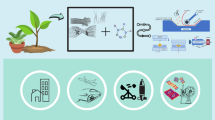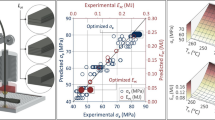Abstract
Wood–plastic composites (WPC) were produced with white birch pulp fibers of different aspect ratios (length-to-diameter), high-density polyethylene, and using two common processes: extrusion or injection molding. Three additive levels were also used: no additive, compatibility agent, and process lubricant. Fiber size was measured with an optical fiber quality analyzer. Tensile properties of WPC were measured and modeled as a function of fiber aspect ratio. Models were fitted to experimental values using the minimum sum of squared error method. A shift from the oriented fiber case (injection molding) to the randomly oriented fiber case (extrusion) was achieved using a fiber orientation factor. Fiber/matrix stress transfer increased with increasing fiber aspect ratio. Stress transfer was reduced with the use of process lubricant. Unexpectedly, the compatibility agent had the same effect. Fiber strength and stiffness contributions to the composite were lower than those of intrinsic fiber properties.





Similar content being viewed by others
References
Baïlon JP, Dorlot JM (2000) Des matériaux, troisième édition. Presses Internationales Polytechnique, Montréal
Beckermann GW, Pickering KL (2009) Engineering and evaluation of hemp fibre reinforced polypropylene composites: micro-mechanics and strength prediction modelling. Composites Part A 40:210–217
Clemons C (2002) Wood-plastic composites in the United States-The interfacing of two industries. Forest Prod J 52(6):10–18
Cox HL (1952) The elasticity and strength of paper and other fibrous materials. Br J Appl Phys 3:72–79
Doan TTL, Gao SL, Mäder E (2006) Jute/polypropylene composites I. Effect of matrix modification. Compos Sci Technol 66:952–963
Gibson RF (2007) Principles of composite material mechanics. CRC Press, New York
Godara A, Raabe D, Bergmann I, Putz R, Müller U (2009) Influence of additives on the global mechanical behavior and the microscopic strain localization in wood reinforced polypropylene composites during tensile deformation investigated using digital image correlation. Compos Sci Technol 69:139–146
Halpin JC (1969) Stiffness and expansion estimates for oriented short fiber composites. J Compos Mater 3:732–734
Herra-Franco PJ, Valadez-González A (2005) A study of the mechanical properties of short natural-fiber reinforced composites. Composites Part B 36:597–608
Kalaprasad G, Joseph K, Thomas S, Pavithran C (1997) Theoretical modelling of tensile properties of short sisal fibre-reinforced low-density polyethylene composites. J Mater Sci 32:4261–4267
Kelly A (1973) Strong solids, vol 2. Clarendon Press, Oxford
Li H, Law S, Sain M (2004) Process rheology and mechanical property correlationship of wood flour-polypropylene composites. J Reinf Plast Compos 23(11):1153–1158
Mark RE, Habeger CC, Borch J, Lyne BM, Murakami K (2002) Handbook of physical testing of paper, vol 1, 2nd edn. Marcel Dekker, New York
Marklund E, Varna J, Neagu CR, Gamstedt KE (2008) Stiffness of aligned wood fiber composites: effect of microstructure and phase properties. J Compos Mater 42(22):2377–2405
Migneault S, Koubaa A, Erchiqui F, Chaala A, Englund K, Wolcott MP (2009) Effects of processing method and fiber size on the structure and properties of wood–plastic composites. Composites Part A 40:80–85
Neagu CR, Gamstedt KE, Berthold F (2006) Stiffness contribution of various wood fibers to composite materials. J Compos Mater 40(8):663–698
TAPPI (1996) Zero–span breaking strength of pulp (dry zero–span tensile). Standard T 231 cm–96. Technical association of the pulp and paper industry, Atlanta
Rowell RM (2007) Challenges in biomass–thermoplastic composites. J Polym Environ 15:229–235
Simonsen J (1997) Efficiency of reinforcing materials in filled polymer composites. Forest Prod J 47(1):74–81
Smith PM, Wolcott MP (2006) Opportunities for wood/natural fiber–plastic composites in residential and industrial applications. Forest Prod J 56(3):4–11
Smook GA (2002) Handbook for pulp & paper technologists, 3rd edn. Angus Wilde publications, Vancouver
Sretenovic A, Müller U, Gindl W (2006) Mechanism of stress transfer in a single wood fibre–LDPE composite by means of electronic laser speckle interferometry. Composites Part A 37(9):1406–1412
Acknowledgments
The authors are grateful to the Canada Research Chair Program, the Ministère du développement économique et de l’innovation et de l’Exportation (MDEIE) du Québec, NSERC, Caisse Populaire Desjardins, Tembec, and the UQAT Foundation for financial support. The authors wish to thank Professor Michael Wolcott and Dr. Karl Englund from Washington State University for granting access to the Wood Engineering Material Laboratory and for their collaboration on this project.
Author information
Authors and Affiliations
Corresponding author
Rights and permissions
About this article
Cite this article
Migneault, S., Koubaa, A., Erchiqui, F. et al. Application of micromechanical models to tensile properties of wood–plastic composites. Wood Sci Technol 45, 521–532 (2011). https://doi.org/10.1007/s00226-010-0351-5
Received:
Published:
Issue Date:
DOI: https://doi.org/10.1007/s00226-010-0351-5




